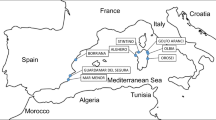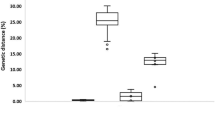Abstract
The scuticociliate Miamiensis avidus is a histophagous parasite that causes high mortality in cultured marine fishes. Small subunit ribosomal RNA (SSU rRNA) and mitochondrial cytochrome c oxidase subunit 1 (cox1) genes were analyzed for 21 strains of M. avidus isolated from diseased olive flounder (Paralichthys olivaceus), ridged-eye flounder (Pleuronichthys cornutus), and spotted knifejaw (Oplegnathus fasciatus) in Korea and Japan (collected in 2003–2007). Analysis of SSU rRNA gene sequences (1,759 bp) indicates they are very conserved with less than 0.17% (3 nucleotides) differences suggesting that SSU rRNA are useful to identify M. avidus; however, the cox1 gene (900 bp) has higher variations with intraspecific divergences up to 5.67% (51 nucleotides). A distance tree of cox1 gene sequences based on a neighbor-joining analysis can separate 21 strains into five cox1 types (two heterogeneous clusters and three individual branches). The cox1-type matches with serotype of strains but do not reflect geographical origins, host species, or pathogenicity.


Similar content being viewed by others
References
Barth D, Krenek S, Fokin SI, Berendonk TU (2006) Intraspecific genetic variation in Paramecium revealed by mitochondrial cytochrome c oxidase I sequences. J Eukaryot Microbiol 53:20–25
Corliss JO (1953) Silver impregnation of ciliated protozoa by the Chatton–Lwoff technique. Stain Technol 28:97–100
Chantangsi C, Lynn DH, Brandl MT, Cole JC, Hetrick N, Ikonomi P (2007) Barcoding ciliates: a comprehensive study of 75 isolates of the genus Tetrahymena. Int J Syst Evol Microbiol 57:2412–2425
Chantangsi C, Lynn DH (2008) Phylogenetic relationships within the genus Tetrahymena inferred from the cytochrome c oxidase subunit 1 and the small subunit ribosomal RNA genes. Mol Phylogenet Evol 49: 979–987
Dunthorn M, Foissner W, Katz LA (2008) Molecular phylogenetic analysis of class Colpodea (phylum Ciliophora) using broad taxon sampling. Mol Phylogenet Evol 46:316–327
Dragesco A, Dragesco J, Coste F, Gasc C, Romestand B, Raymond J, Bouix G (1995) Philasterides dicentrarchi, n. sp. (Ciliophora, Scuticociliatida), a histophagous opportunistic parasite of Dicentarchus labrax (Linnaeus, 1758), a reared marine fish. Eur J Protistol 31:327–340
Felsenstein J (1985) Confidence limits on phylogenies: an approach using the bootstrap. Evolution 39:783–791
Foissner W (1991) Basic light and scanning electron microscopic methods for taxonomic studies of ciliated protozoa. Eur J Protistol 27:313–330
Gentekaki E, Lynn DH (2009) High-level genetic diversity but no population structure inferred from nuclear and mitochondrial markers of the peritrichous ciliate Carchesium polypinum in the Grand River Basin (North America). Appl Environ Microbiol 75:3187–3195
Goding JW (1993) Production of monoclonal antibodies. In: Goding JW (ed) Monoclonal antibodies: principles and practice. Academic, London, pp 175–176
Hebert PDN, Cywinska A, Ball SL, deWaard JR (2003) Biological identification through DNA barcodes. Proc R Soc Lond B Biol Sci 270:313–321
Hillis DM, Dixon MT (1991) Ribosomal DNA: molecular evolution and phylogenetic inferences. Q Rev Biol 66:411–446
Hirt RP, Dyal PL, Wilkinson M, Finlay BJ, Roberts DM, Embley TM (1995) Phylogenetic relationships among Karyorelictids and Heterotrichs inferred from small subunit rRNA sequences: resolution at the base of the ciliate tree. Mol Phylogenet Evol 4:77–87
Iglesias R, Paramá A, Alvarez MF, Leiro J, Fernández J, Sanmartin ML (2001) Philasterides dicentrarchi (Ciliophora, Scuticociliatida) as the causative agent of scuticociliatosis in farmed turbot Scophthalmus maximus in Galicia (NW Spain). Dis Aquat Org 46:47–55
Jung SJ, Kitamura S-I, Song JY, Joung IY, Oh MJ (2005) Complete small subunit rRNA gene sequence of the scuticociliate Miamiensis avidus pathogenic to olive flounder Paralichthys olivaceus. Dis Aquat Org 64:159–162
Jung SJ, Kitamura S-I, Song JY, Oh MJ (2007) Miamiensis avidus (Ciliophora: Scuticociliatida) causes systemic infection of olive flounder Paralichthys olivaceus and is a senior synonym of Philasterides dicentrarchi. Dis Aquat Org 73:227–234
Kim SM, Cho JB, Lee EH, Kwon SR, Kim SK, Nam YK, Kim KH (2004a) Occurrence of scuticociliatosis in olive flounder Paralichthys olivaceus by Philasterides dicentrarchi (Ciliophora: Scuticociliatida). Dis Aquat Org 62:233–238
Kim SM, Cho JB, Lee EH, Kwon SR, Kim SK, Nam YK, Kim KH (2004b) Pseudocohnilembus persalinus (Ciliophora: Scuticociitida) is an additional species causing scuticociliatosis in olive flounder Paralichthys olivaceus. Dis Aquat Org 62:239–244
Kimura M (1980) A simple method of estimating evolutionary rates of base substitutions through comparative studies of nucleotide sequences. J Mol Evol 16:111–120
Lee EH, Kim KH (2008) Can the surface immobilization antigens of Philasterides dicentrarchi (Ciliophora: Scuticociliatida) be used as target antigens to develop vaccines in cultured fish? Fish Shellfish Immunol 24:142–146
Lynn DH (2008) The ciliated protozoa. Characterization, classification, and guide to the literature. 3rd Ed. Springer, Dordrecht
Lynn DH, Strüder-Kypke MC (2006) Species of Tetrahymena identical by small subunit rRNA gene sequences are discriminated by mitochondrial cytochrome c oxidase I gene sequences. J Eukaryot Microbiol 53:385–387
Medlin L, Elwood HJ, Stickel S, Sogin ML (1988) The characterization of enzymatically amplified eukaryotic 16S-like rRNA-coding regions. Gene 71:491–499
Miao M, Song W, Clamp JC, Al-Rasheid KA, Al-Khedhairy AA, Al-Arifi S (2009) Further consideration of the phylogeny of some “traditional” heterotrichs (Protista, Ciliophora) of uncertain affinities, based on new sequences of the small subunit rRNA gene. J Eukaryot Microbiol 56:244–250
Munday BL, O’Donoghue PJ, Watts M, Rough K, Hawkesford T (1997) Fatal encephalitis due to the scuticociliate Uronema nigricans in sea-caged, southern bluefin tuna Thunnus maccoyii. Dis Aquat Org 30:17–25
Paramá A, Arranz JA, Alvarez MF, Sanmartín ML, Leiro J (2006) Ultrastructure and phylogeny of Philasterides dicentrarchi (Ciliophora, Scuticociliatia) from farmed turbot in NW Spain. Parasitology 132:555–564
Rossteuscher S, Wenker C, Jermann T, Wahli T, Oldenberg E, Schmidt-Posthaus H (2008) Severe scuticociliate (Philasterides dicentrarchi) infection in a population of sea dragons (Phycodurus eques and Phyllopteryx taeniolatus). Vet Pathol 45:546–550
Saitou N, Nei M (1987) The neighbor-joining method: a new method for reconstructing phylogenetic trees. Mol Biol Evol 4:406–425
Saunders GW (2005) Applying DNA barcoding to red macroalgae: a preliminary appraisal holds promise for future applications. Philos Trans R Soc Lond B Biol Sci 360:1879–1888
Schlegel M, Elwood HJ, Sogin ML (1991) Molecular evolution in hypotrichous ciliates: sequence of the small subunit ribosomal RNA genes from Onychodromus quadricornutus and Oxytricha granulifera (Oxytrichidae, Hypotrichida, Ciliophora). J Mol Evol 32:64–69
Schmidt SL, Bernhard D, Schlegel M, Foissner W (2007a) Phylogeny of the Stichotrichia (Ciliophora; Spirotrichea) reconstructed with nuclear small subunit rRNA gene sequences: discrepancies and accordances with morphological data. J Eukaryot Microbiol 54:201–209
Schmidt SL, Foissner W, Schlegel M, Bernhard D (2007b) Molecular phylogeny of the Heterotrichea (Ciliophora, Postciliodesmatophora) based on small subunit rRNA gene sequences. J Eukaryot Microbiol 54:358–363
Snoeyenbos-West OLO, Salcedo T, McManus GB, Katz LA (2002) Insights into the diversity of choreotrich and oligotrich ciliates (Class: Spirotrichea) based on genealogical analyses of multiple loci. Int J Syst Evol Microbiol 52:1901–1913
Song JY, Kitamura S-I, Oh MJ, Kang HS, Lee JH, Tanaka SJ, Jung SJ (2009a) Pathogenicity of Miamiensis avidus (syn. Philasterides dicentrarchi), Pseudocohnilembus persalinus, Pseudocohnilembus hargisi and Uronema marinum (Ciliophora, Scuticociliatida). Dis Aquat Org 83:133–143
Song JY, Sasaki K, Okada T, Sakashita M, Kawakami H, Matsuoka S, Kang HS, Nakayama K, Jung SJ, Oh MJ, Kitamura S-I (2009b) Antigenic differences of the scuticociliate Miamiensis avidus from Japan. J Fish Dis 32:1027–1034
Song W (2000) Morphological and taxonomical studies on some marine scuticociliates from China sea, with description of two new species, Philasterides armatalis sp. n. and Cyclidium varibonneti sp. n. (Protozoa: Ciliophora: Scuticociliatida). Acta Protozool 39:295–322
Song W, Wilbert N (2000) Redefinition and redescription of some marine scuticociliates from China, with report of a new species, Metanophrys sinensis nov. spec. (Ciliophora, Scuticociliatida). Zool Anz 239:45–74
Song W, Wilbert N (2002) Reinvestigations of three “well-known” marine scuticociliates: Uronemella filificum (Kahl, 1931) nov. gen., nov. comb., Pseudocohnilembus hargisi Evans & Thompson, 1964 and Cyclidium citrullus Cohn 1865, with description of the new genus Uronemella (Protozoa, Ciliophora, Scuticociliatida). Zool Anz 241:317–331
Strüder-Kypke MC, Lynn DH (2010) Comparative analysis of the mitochondrial cytochrome c oxidase subunit I (COI) gene in ciliates (Alveolata, Ciliophora) and evaluation of its suitability as a biodiversity marker. Syst Biodivers 8:131–148
Tamura K, Dudley J, Nei M, Kumar S (2007) MEGA4: molecular evolutionary genetics analysis (MEGA) software version 4.0. Mol Biol Evol 24:1596–1599
Tautz D, Arctander P, Minelli A, Thomas RH, Vogler AP (2003) A plea for DNA taxonomy. Trends Ecol Evol 18:70–74
Thompson JC, Moewus L (1964) Miamiensis avidus n. g., n. sp., a marine facultative parasite in the ciliate order Hymenostomatida. J Protozool 11: 378–381
Wang Y, Song W, Warren A, Al-Rasheid KA, Al-Quraishy SA, Al-Farraj SA, Hu X, Pan H (2009) Descriptions of two new marine scuticociliates, Pleuronema sinica n. sp. and P. wilberti n. sp. (Ciliophora: Scuticociliatida), from the Yellow Sea, China. Eur J Protistol 45:29–37
Ward RD, Zemlak TS, Innes BH, Last PR, Hebert PD (2005) DNA barcoding Australia’s fish species. Philos Trans R Soc Lond B Biol Sci 360:1847–1857
Weisse T, Strüder-Kypke MC, Berger H, Foissner W (2008) Genetic, morphological, and ecological diversity of spatially separated clones of Meseres corlissi Petz and Foissner, 1992 (Ciliophora, Spirotrichea). J Eukaryot Microbiol 55:257–270
Acknowledgements
This work was supported by the Korea Research Foundation Grant funded by the Korean Government (MOEHRD, Basic Research Promotion Fund) (KRF-313-2007-2-F00076), and by the Natural Science and Engineering Research Council (NSERC) Discovery Grant to PTKW. The work of MSK was supported through funding to the Canadian Barcode of Life Network from Genome Canada, an NSERC Discovery Grant to D.H. Lynn and other sponsors (listed at http://www.BOLNET.ca).
Author information
Authors and Affiliations
Corresponding author
Rights and permissions
About this article
Cite this article
Jung, SJ., Im, EY., Strüder-Kypke, M.C. et al. Small subunit ribosomal RNA and mitochondrial cytochrome c oxidase subunit 1 gene sequences of 21 strains of the parasitic scuticociliate Miamiensis avidus (Ciliophora, Scuticociliatia). Parasitol Res 108, 1153–1161 (2011). https://doi.org/10.1007/s00436-010-2157-7
Received:
Accepted:
Published:
Issue Date:
DOI: https://doi.org/10.1007/s00436-010-2157-7




